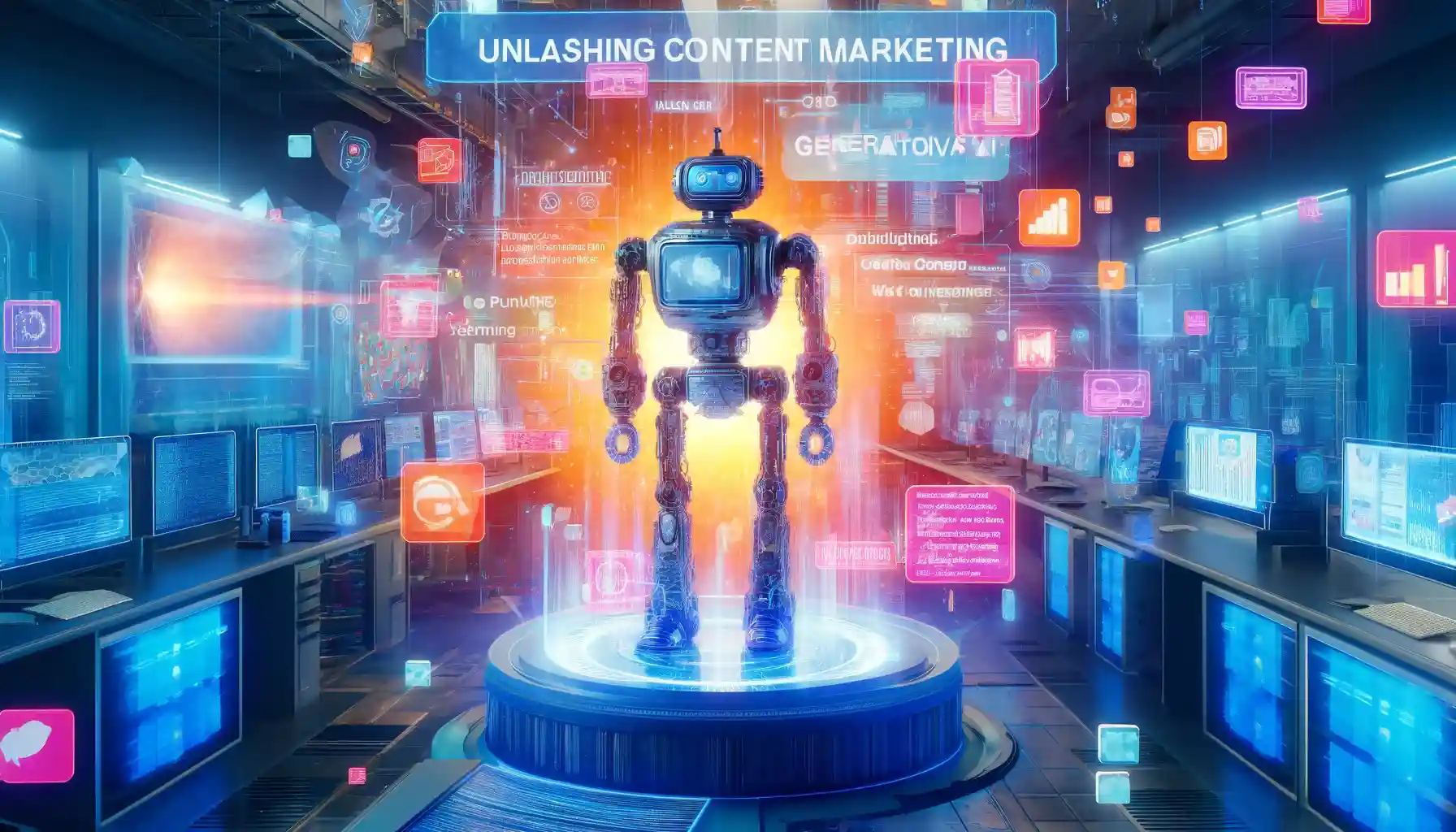Introduction
Content marketing is crucial for businesses to attract, engage and retain their audiences. However, creating high-quality, personalized content at scale across multiple channels is an ongoing challenge. From blogs and emails to social media posts and advertising copy, the content demands are immense.
This is where generative artificial intelligence (AI) can be a game-changer. AI writing tools can now assist with ideating, drafting, and optimizing all kinds of content remarkably quickly. When combined with human creativity and domain expertise, AI has the potential to supercharge content marketing efforts.
In this comprehensive blog, we’ll explore the current state of generative AI for content creation and optimization. We’ll dive into its capabilities, limitations, best practices, tools, and the implications for content teams. By the end, you’ll have a clear understanding of how to effectively leverage this technology to enhance your content strategy.
What is Generative AI for Content?
Generative AI refers to artificial intelligence models that can generate all-new content (text, images, audio, code) from minimal inputs like text prompts or data points. They use machine learning techniques like transformers and diffusion to understand patterns in existing data and then create completely new, original content pieces.
Some of the most popular generative AI models include:
- GPT-3 (text generation)
- DALL-E and Stable Diffusion (image generation)
- ChatGPT (conversational QA and text generation)
These models are trained on massive datasets to develop an understanding of topics, contexts, and styles. When given a prompt, they can then generate highly coherent and contextually relevant content outputs.
For content marketing, generative AI is being leveraged for:
- Drafting long-form blogs, articles, and ebooks
- Generating email newsletters, social media posts
- Creating ad copy, product descriptions
- Assisting with research and ideation
- Automating different content customizations and optimizations
While not perfect, the quality and speed of generative AI for content tasks is rapidly improving with continued training and iterations on these models.
Powering Content Creation at Scale
One of the biggest benefits of generative AI is its ability to create substantially more content, much faster than humans alone. By leveraging AI writing assistants, content teams can scale their operations significantly.
Blog Writing and Articles
With a well-crafted prompt describing the topic, tone, and any specifics, AI tools can quickly generate drafts of long-form content like blogs and articles. The AI analyzes relevant information in its training data to compose a cohesive narrative structure, introduction, heading, body, and conclusion.
For example, tools like Jasper AI have specific recipes and templates to generate blogs, essays, listicles, creative stories and more at the click of a button. The human then reviews, edits and fact-checks the draft.
Content teams can create many more long-form pieces per month, freeing up writers’ time for strategy, messaging, and polish editing.
Emails and Messaging
AI writing assistants excel at generating engaging copy for Email newsletters, SMS/push campaigns, chat dialogues and more. By providing the tool with audience personas, brand guidelines and context details, it produces hyper-personalized copy at scale.
Many marketing teams are using AI to create high-converting emails sequences, automated chat responses and even experiential interactive fiction stories for campaigns.
Social Media Content
The constant need for fresh, audience-tailored social media posts across multiple channels makes this a tedious task for humans. Generative AI can draft dozens of tweets, posts, reels and stories based on a few prompts about the subject and goals.
Companies are employing AI tools to create relatable, on-brand social copy at scale for feeds, groups and paid social campaigns. AI handles the content heavy-lifting while creators focus on strategy.
Ad Copy and Product Descriptions
Another labor-intensive area where generative AI shines is crafting compelling ad copy and product descriptions. E-commerce brands leverage AI to generate thousands of unique descriptions based on product details and SEO guidelines.
Digital marketers use AI Copy tools to rapidly create and test ad copy variations across Google Ads, Facebook Ads and more. AI takes care of drafting, A/B testing descriptions and constantly optimizing wording for more clicks and conversions.
Ideation and Research Assistance
Beyond full content generation, AI assistants can be hugely helpful for ideating new angles and conducting topical research. They provide insights based on their training data and frameworks to stimulate human creativity.
Writers use AI to get new content ideas, suggest headlines, source data points, alternative phrasings and more. This augments their work rather than fully replacing it.
The possibilities are endless as to how generative AI can enhance content workflows. However, there are limitations and best practices to keep in mind.
AI-Driven Content Optimization
Beyond content creation itself, AI provides powerful tools to optimize the positioning, distribution and performance of that content. Let’s explore some of these capabilities:
SEO Optimization
Using natural language processing (NLP) and machine learning, AI models can deeply analyze content for semantic relevance and alignment with search engine algorithms. This allows for optimizations far beyond simple keyword usage.
Tools like MarketMuse use AI to provide content briefs, recommendations and audits to ensure created pieces have the right scope, structure and substance to maximize SEO visibility.
AI assistants can also automatically optimize headings, titles, meta descriptions and more for higher search rankings.
UX and Conversion Optimization
The goal of content is often to engage readers and drive conversions. AI can help here by suggesting A/B test copy variations to resonate better with audiences.
Conversion.ai’s AI optimization solution uses machine learning to generate and test thousands of UX copy permutations (CTAs, headlines, form fields etc.) to improve click-through and conversion rates.
Other tools use AI to personalize content experiences by matching text, offers and visuals to each visitor’s unique characteristics and journey touchpoints.
Multimodal Content Creation
AI is powering multimodal content creation experiences that blend different modalities like text, audio, images and videos. For example, DALL-E allows generating custom imagery based on text prompts, which can complement blog posts.
Tools like Scenario make it easy to create AI-narrated videos and animations from basic outlines. The possibilities for rich, multi-format content experiences are rapidly expanding through generative AI.
Audience Segmentation and Targeting
Building on NLP capabilities, AI models can deeply analyze audience data (demographics, interests,behavior) to create granular segments and accurate persona profiles.
This helps marketers tailor everything – messaging, channels, formats, CTAs and more – to highly specific segments rather than a one-size-fits-all approach. AI enables true omnichannel personalization at scale.
As you can see, AI opens up a whole new world for precisely optimizing content creation, distribution and measurement in sync with goals. However, there are challenges to watch out for.
Challenges & Limitations of Generative AI for Content
While highly powerful, generative AI is not a magic solution. There are several limitations to be aware of:
Factual Errors and Hallucinations
A major concern with current AI models is their tendency to “hallucinate” or generate incorrect or contradictory statements that sound plausible. They can also bake in societal biases present in their training data.
Without robust quality checks, there are risks of releasing inaccurate, biased or inconsistent content. AI outputs are not a reliable sole source of truth.
Risk of Plagiarism and Copyright Issues
Since the training data for models like GPT-3 include large portions of the open internet, their outputs may unintentionally reproduce copyrighted text. This makes them susceptible to plagiarism and intellectual property concerns.
Some tools analyze for plagiarized text but it’s a risk to monitor. There could also be challenges around who owns the rights over AI-generated creative works.
Lack of True Originality and Creativity
As impressive as they are, generative AIs today do not possess true creativity or emotional intelligence. They cannot generate truly original or unexpected ideas from scratch.
AI content runs the risk of feeling generic or derivative if not combined with the ingenuity and lived experiences that only humans possess. There are also limitations around generating highly niche, specialized content.
Potential for Low Quality, Nonsensical Outputs
When not given clear, precise prompts or when pushing generative AI beyond what it was designed for, their outputs can quickly become low quality, confusing or nonsensical.
There needs to be well-defined processes and quality safeguards in place to prevent poor AI outputs from reaching production content environments.
Over-Reliance and Job Replacement Concerns
With AI being hyped as a powerful productivity tool, there could be expectations and pressures to over-rely on it. An over-reliance on AI for content creation runs the risk of deprioritizing the crucial roles of strategy, messaging and quality control.
There are also concerns around AI’s impact on certain content roles like writers, designers and editors. While AI can augment and assist these professionals, it’s not likely to fully automate or replace humans anytime soon given the limitations discussed above.
Content teams will need to find the right balance between leveraging AI capabilities and retaining essential human elements like creative direction, brand voice and quality assurance.
Best Practices and Tools
To harness generative AI responsibly and effectively for content marketing, here are some best practices and popular tools to consider:
AI Writing Assistants
- Jasper AI
- Copy.ai
- OpenAI’s GPT-3 Playground
- AI21 Labs
- Writesonic
Multimodal Creative Tools
- DALL-E
- Stable Diffusion
- Midjourney
- Scenario
Content Optimization Solutions
- MarketMuse
- Frase
- Surfer SEO
- Conversion.ai
- Unbounce AI Writer
Effective Prompt Engineering
- Provide clear context and instructions
- Use examples of desired output
- Iterate prompts for better results
- Embrace a feedback loop
Human-AI Collaborative Workflows
- Use AI as an ideation and drafting aid
- Humans for strategy, messaging, quality review
- Editorial and approval processes
- Blend AI and human-generated content
By following these best practices and leveraging cutting-edge AI tools, content teams can turbocharge their output while maintaining human oversight, brand voice and quality standards.
Q&A
Is AI coming for content writers’ jobs?
While AI can automate some content creation tasks, quality writers with strong strategic and creative skills will remain in high demand. AI should be viewed as an augmentation tool rather than a direct job replacement.
How do I pick the right AI tool for my needs?
Assess your specific content goals, budgets and existing workflows. Try out different tools to see which integrates best with how you work. Look for easy customization, quality controls and human/AI collaboration features.
What are the costs of using generative AI?
Many AI writing tools have monthly subscription fees from $20 to $100+ per user. Some have usage-based pricing models as well. Additional costs may be incurred for companion tools like image/video AI, optimization platforms etc.
How do I ensure high quality AI-generated content?
Establish rigorous review, editing and fact-checking processes. Use AI outputs as drafts rather than finished products. Create guidelines and quality rubrics. Blend AI and human-generated content appropriately.
What skills will content teams need to work with AI?
Skills like prompt engineering, AI workflow design, data analysis and tech-savviness will be valuable. Creativity, brand stewardship and business acumen will remain critical human strengths.
Conclusion
Key Takeaways:
- Generative AI can massively boost content creation velocity and optimization capabilities
- But AI has limitations around factual accuracy, originality and true domain expertise
- A hybrid human+AI model following best practices is optimal for content marketing
- Content teams must stay rooted in strategy while adding AI tools to their stack
Looking ahead, generative AI models will only get more advanced with improved reasoning, coherence, and multimodal content generation abilities. We can expect rapid commoditization of basic text generation soon.
So now is the time for content teams and marketers to start responsibly experimenting with AI assistants and learning how to blend these capabilities into their workflows. The content creation landscape is being radically reshaped – it’s up to you to unlock generative AI’s potential while upholding quality and human ingenuity.


